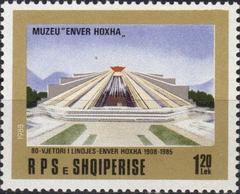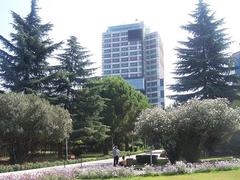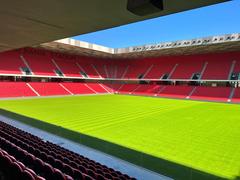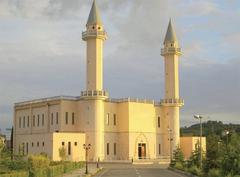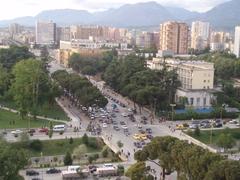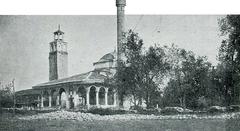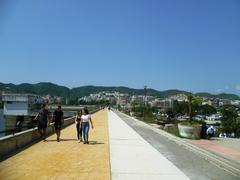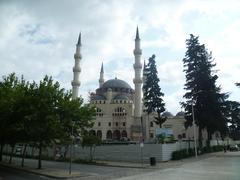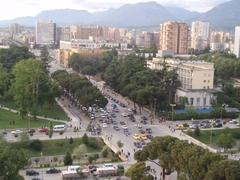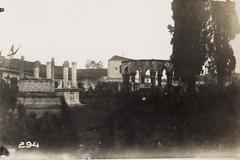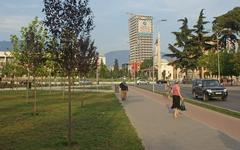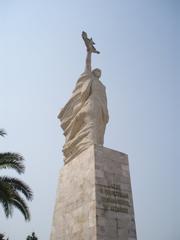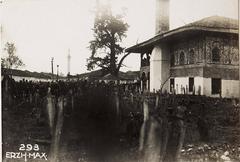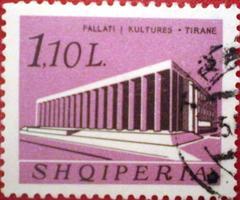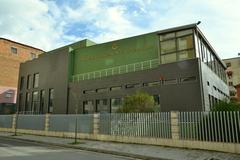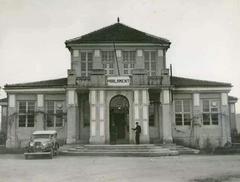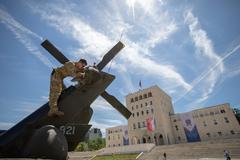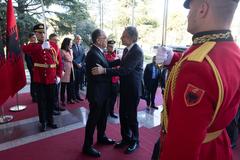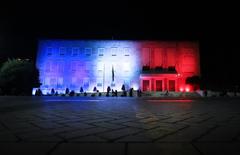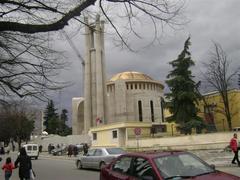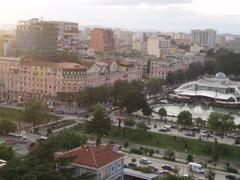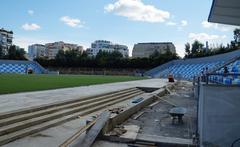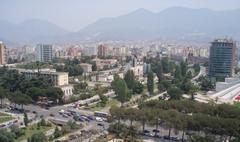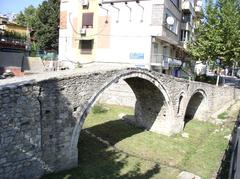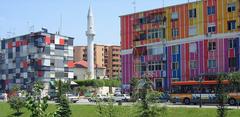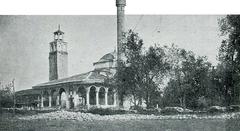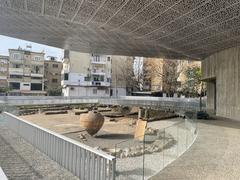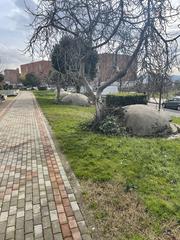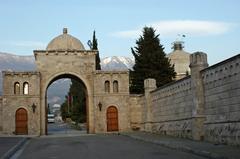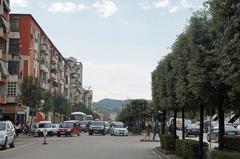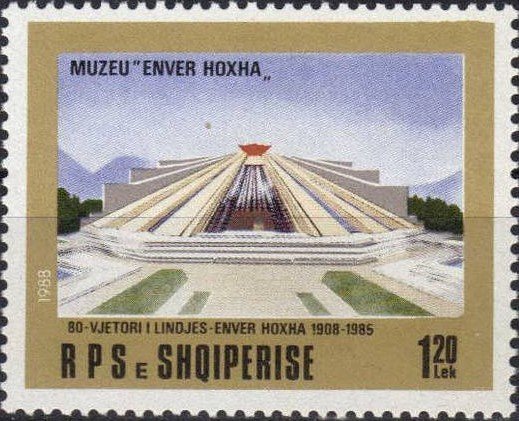
Pyramid of Tirana: Visiting Hours, Tickets, and Historical Significance
Date: 14/06/2025
Introduction
The Pyramid of Tirana (Piramida e Tiranës) stands as one of Albania’s most iconic and architecturally distinctive landmarks. Originally constructed in 1988 as a museum to honor Enver Hoxha, Albania’s communist leader, the Pyramid has since transformed into a vibrant cultural and educational hub, reflecting the country’s journey from a closed regime to an open, creative society. This comprehensive guide details the Pyramid’s history, architectural evolution, practical visitor information, and cultural significance, ensuring you make the most of your visit to this central Tirana attraction (Ex Utopia; Architectuul; Albania Tour Guide).
Table of Contents
- Introduction
- Historical Background
- Architectural Design and Renovation
- Cultural Role and Significance
- Practical Visitor Information
- Climbing & Exploring the Pyramid
- Travel Tips and Best Times to Visit
- FAQs
- Conclusion and Call to Action
- References
Historical Background
Origins and Construction
The Pyramid of Tirana was envisioned in the mid-1980s, following the death of Enver Hoxha. Designed by Pranvera Hoxha (Enver Hoxha’s daughter), Klement Kolaneci, Pirro Vaso, and Vladimir Bregu, the structure was inaugurated in 1988 as the Enver Hoxha Museum. Its site, between the Prime Minister’s office and Dajti Hotel, was chosen for its symbolic connection to Mount Dajti and Tirana’s political heart (Architectuul; Ex Utopia).
Architectural Features and Symbolism
The Pyramid is a prime example of late socialist modernism, featuring a star-shaped, symmetrical design with sloping concrete and glass facades. The structure’s geometry, processional stairs, and spatial grandeur reflect both ideological ambition and the Brutalist aesthetic of its era. At completion, it was the most expensive building of communist Albania, a stark contrast to the widespread poverty of the time (MVRDV).
Communist Legacy and Early Years
From 1988 to 1991, the Pyramid served as a museum glorifying Enver Hoxha, reinforcing his cult of personality (Albania360). With the fall of communism, the Pyramid’s symbolic meaning shifted dramatically. Its contents were removed, and the building’s future became the subject of heated debate as many Albanians saw it as a relic of authoritarianism.
Post-Communist Transformation
After 1991, the Pyramid was repurposed multiple times: as a conference center, TV station, NATO base during the Kosovo War, and event venue (MVRDV). Despite varied uses, the structure suffered neglect and vandalism. Its sloping sides became a gathering place for youth, symbolizing a public reclamation of space. Proposals for demolition met widespread resistance, and, by the late 2010s, a consensus emerged to preserve and repurpose the landmark (MVRDV).
Modern Revival
A major renovation, completed in 2023 by Dutch firm MVRDV in partnership with the Albanian-American Development Foundation and the Municipality of Tirana, reimagined the Pyramid as a center for culture, education, and technology. The redesign introduced vibrant modular “boxes,” safe rooftop steps, and open, accessible interiors, making the monument an inclusive urban space (Designboom; arqa.com; Visit Tirana).
Architectural Design and Renovation
Original Design
Covering nearly 12,000 square meters, the Pyramid’s low, sloping form emphasized modernity and permanence. The original white marble cladding and central apex created a dramatic cityscape silhouette (Albania Tour Guide; Designboom).
Renovation Highlights
- Safe rooftop access via concrete steps and handrails
- Colorful modular interior “boxes” for classrooms, studios, and cafes
- Open atrium with natural light and greenery
- Full accessibility with ramps and lifts (Arch2O; archello.com; Archeyes)
The renovation exemplifies adaptive reuse and sustainable urban development, aligning with global goals for inclusive, innovative cities.
Cultural Role and Significance
Symbolism
The Pyramid’s transformation from a monument to dictatorship into a beacon of creativity and community engagement mirrors Albania’s broader social renewal (Albania Tour Guide; Euronews). Its survival and adaptive reuse reflect the city’s commitment to confronting its past while fostering openness and dialogue.
Community and Education
Today, the Pyramid hosts TUMO Tirana, an innovative after-school center offering free courses in tech and creative fields for youth aged 12–18 (Arch2O). The space also accommodates art exhibitions, workshops, festivals, and community events, making it a lively hub for locals and tourists alike.
Urban Integration
Renovated parklands, cafes, and public seating integrate the Pyramid into Tirana’s urban fabric, promoting community use and vibrant street life (arqa.com).
Artistic Expression
The Pyramid has long been a canvas for graffiti and street art, reflecting youthful energy and social commentary. While much of the facade has been restored, elements of this artistic tradition persist (Secret Attractions).
Practical Visitor Information
Visiting Hours
- Standard hours: Daily, 8:00 AM – 10:00 PM (may vary during events and holidays)
- Rooftop access: During opening hours
- Note: Special events may affect hours; check Visit Tirana or the official TUMO Center Tirana site for updates (visitalbania.zenith.travel)
Tickets and Admission
- General admission: Free
- Workshops/exhibitions: May require registration or a small fee; see event listings or the TUMO Center website
Accessibility
- Ground-level: Fully accessible for visitors with disabilities
- Rooftop climb: Moderately steep; handrails provided; not suitable for all mobility levels
- Lifts and ramps: Installed throughout the building (archello.com)
Getting There
- Address: Bulevardi Dëshmorët e Kombit, Tirana
- On foot: 5–10 minutes from Skanderbeg Square
- Public transport: Multiple city bus lines stop nearby
- Taxi: Widely available
- Parking: Limited; public transport or walking recommended (Visit Tirana)
Nearby Attractions
- Skanderbeg Square
- National History Museum
- Et’hem Bey Mosque
- The Cloud art installation
- Rinia Park
- Blloku nightlife district (Salt in Our Hair)
Events and Nightlife
The Pyramid hosts a calendar of technology workshops, art exhibitions, concerts, and festivals. By night, the illuminated structure and rooftop attract visitors for city views and evening events. On-site cafes and bars complement the experience (ArchDaily; Bucketlistly Blog).
Climbing & Exploring the Pyramid
Climbing the Pyramid’s exterior steps to the rooftop is a highlight, offering panoramic views across Tirana and towards the Dajti Mountains. The ascent is safe for most visitors, with handrails and wide steps, but care is needed during wet weather. The rooftop platform provides an excellent spot for photography and relaxation (The Endless Travellers).
Inside, explore the TUMO Center’s creative spaces, enjoy a coffee, or participate in public exhibitions and workshops. The open-plan design encourages interaction and discovery (Archeyes).
Travel Tips and Best Times to Visit
- Best time: June offers pleasant weather (highs ~27°C/80°F)
- Crowds: Weekends and evenings are busiest; for a quieter visit, come on weekday mornings
- Dress: Comfortable shoes for climbing; casual attire suitable
- Safety: The area is well-patrolled and considered safe, but keep personal belongings secure (Matias Travel)
- Duration: 1–2 hours for a standard visit; longer if attending an event
Frequently Asked Questions (FAQ)
Q: What are the Pyramid of Tirana’s visiting hours?
A: Open daily, 8:00 AM – 10:00 PM (subject to change during events/holidays).
Q: Is there an admission fee?
A: General access is free; some events/workshops may require tickets.
Q: Is the Pyramid accessible to visitors with disabilities?
A: Ground-level areas are fully accessible; rooftop climb is not recommended for all.
Q: How do I get there?
A: Central Tirana; walkable from Skanderbeg Square, accessible by public transport or taxi.
Q: Are guided tours available?
A: Select workshops/events offer guided experiences; check with TUMO Center or local tour companies.
Conclusion and Call to Action
The Pyramid of Tirana is more than a monument—it’s a living symbol of Albania’s resilience and creative spirit. Its transformation from a communist-era museum to a thriving cultural and educational venue demonstrates how architecture can bridge history and innovation. With free admission, panoramic views, and a diverse program of workshops and events, the Pyramid is a must-visit for anyone exploring Tirana.
Plan your visit:
- Check official sources for current hours and events
- Download the Audiala app for real-time updates
- Follow us on social media for insider tips and event highlights
- Explore related guides to make the most of your Tirana adventure
References
- Pyramid of Tirana: Visiting Hours, Tickets, and Historical Guide to Tirana’s Iconic Monument, 2023, Ex Utopia
- The Tirana Pyramid, 2023, Architectuul
- The Pyramid of Tirana, 2023, MVRDV
- Pyramid of Tirana – The New Identity, The New Face, 2023, Albania360
- Is Tirana Worth Visiting? 19 Reasons to Visit Tirana, 2024, Albania Tour Guide
- The Pyramid of Tirana by MVRDV, 2023, Arch2O
- Pyramid of Tirana: From communist mausoleum to monument to the people, 2023, archello
- The Pyramid of Tirana by MVRDV: A Monument Reborn, 2023, Archeyes
- The Revival of the Pyramid of Tirana, 2023, Visit Tirana
- The Pyramid of Tirana, 2023, arqa.com
- Best Things to Do in Tirana, 2024, Bucketlistly Blog
- The Endless Travellers: 2 Days in Tirana, 2024
- Everything You Need to Know About the Pyramid in Tirana: Past, Present and Future, 2023, Votra Magazine
- Pyramid of Tirana, Wikipedia
- Salt in Our Hair: Exploring Tirana, 2023
- Matias Travel: Best Things to Do in Tirana, 2024
